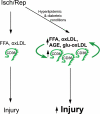CD36: a multi-modal target for acute stroke therapy
- PMID: 19393018
- PMCID: PMC2702148
- DOI: 10.1111/j.1471-4159.2009.05801.x
CD36: a multi-modal target for acute stroke therapy
Abstract
A role for CD36 in the pathogenesis of atherosclerosis, inflammation and lipid metabolism has been well-documented. However, little is known about the role of CD36 in cerebral ischemia. The intent of this review is to develop the concept that CD36, whose functions have been implicated in other pathological events, is a prototypic inflammatory receptor that contributes to the pathogenesis of cerebral ischemia. The importance of CD36 as a treatment target is indicated by the fact that many treatment strategies that are effective in experimental models of stroke exhibit little or no efficacy in clinical trials. The failure of clinical trials may be due to the use of animal models of stroke that do not reflect traditional risk factors for stroke in humans. The discussion will be focused on two risk factors, hyperlipidemia and diabetes, that modulate CD36 responses. Blocking the expression and function of CD36 by pharmacological or genetic means will provide insight not only toward identifying CD36 as a novel molecular target but also for developing effective therapeutic strategies to treat stroke victims. More importantly, coupling clinically relevant conditions with CD36-mediated ischemic injury may provide an appropriate animal model paradigm and develop a scientific understanding that could lead to clinical translational studies involving human subjects.
Figures



References
-
- Abumrad NA, el-Maghrabi MR, Amri EZ, Lopez E, Grimaldi PA. Cloning of a rat adipocyte membrane protein implicated in binding or transport of long-chain fatty acids that is induced during preadipocyte differentiation. Homology with human CD36. J Biol Chem. 1993;268:17665–17668. - PubMed
-
- Argmann CA, Edwards JY, Sawyez CG, O'Neil CH, Hegele RA, Pickering JG, Huff MW. Regulation of macrophage cholesterol efflux through hydroxymethylglutaryl-CoA reductase inhibition: a role for RhoA in ABCA1-mediated cholesterol efflux. J Biol Chem. 2005;280:22212–22221. - PubMed
-
- Bezaire V, Bruce CR, Heigenhauser GJ, Tandon NN, Glatz JF, Luiken JJ, Bonen A, Spriet LL. Identification of fatty acid translocase on human skeletal muscle mitochondrial membranes: essential role in fatty acid oxidation. Am J Physiol Endocrinol Metab. 2006;290:E509–515. - PubMed
-
- Chabowski A, Gorski J, Calles-Escandon J, Tandon NN, Bonen A. Hypoxia-induced fatty acid transporter translocation increases fatty acid transport and contributes to lipid accumulation in the heart. FEBS Lett. 2006;580:3617–3623. - PubMed
Publication types
MeSH terms
Substances
Grants and funding
LinkOut - more resources
Full Text Sources
Other Literature Sources
Medical

